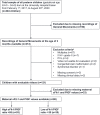The Impact of Increased Maternal sFlt-1/PlGF Ratio on Motor Outcome of Preterm Infants
- PMID: 35846340
- PMCID: PMC9279729
- DOI: 10.3389/fendo.2022.913514
The Impact of Increased Maternal sFlt-1/PlGF Ratio on Motor Outcome of Preterm Infants
Abstract
Background: The sFlt-1 (soluble fms-like tyrosine kinase-1)/PlGF (placental growth factor) ratio serves as a clinical biomarker to predict the hypertensive, placenta-derived pregnancy disorder pre-eclampsia which is often associated with placental dysfunction and fetal growth restriction. Additionally elevated levels also indicate an increased risk for prematurity. However, its predictive value for subsequent neonatal neurological outcome has not been studied.
Objective: This study aimed to evaluate the correlation of maternal sFlt-1/PlGF ratio with early motor outcome of preterm infants. Design/Methods: 88 preterm infants (gestational age ≤ 34 + 0) born between February 2017 and August 2020 at the Department of Obstetrics and Gynecology, University Hospital Essen in Germany, were included, when the following variables were available: maternal sFlt-1/PlGF levels at parturition and general movement assessment of the infant at the corrected age of 3 to 5 months. The infants were stratified into high and low ratio groups according to maternal sFlt-1/PlGF cut-off values of 85. To investigate the early motor repertoire and quality of spontaneous movements of the infant, the Motor Optimality Score (MOS-R) based on antigravity movements and posture patterns, was applied. In the given age, special attention was paid to the presence of fidgety movements. Linear regressions were run to test differences in infants motor repertoire according to the maternal sFlt-1/PIGF ratio.
Results: Linear regression analysis showed that the sFlt-1/PlGF ratio does not predict the MOS-R score (β=≤0.001; p=0.282). However, children with birth weight below the 10th percentile scored significantly lower (mean 20.7 vs 22.7; p=0.035). These children were 91% in the group with an increased ratio, which in turn is a known predictor of low birth weight (β= -0.315; p <0.001). In the group with a high sFlt-1/PLGF ratio above 85 the mothers of female infants had a lower average sFlt-1/PlGF ratio compared to a male infant (median: 438 in female vs. 603 in male infant, p=0.145).
Conclusions: In our cohort, especially low birth weight, which correlated with an elevated sFlt-1/PlGF ratio, had a negative effect on the outcome in the MOS-R. A direct correlation between an increased ratio and a worse motor outcome was not demonstrated.
Keywords: MOS-R; PIGF; infant; motor outcome; prematurity; sFlt-1.
Copyright © 2022 Middendorf, Gellhaus, Iannaccone, Köninger, Dathe, Bendix, Reisch, Felderhoff-Mueser and Huening.
Conflict of interest statement
The authors declare that the research was conducted in the absence of any commercial or financial relationships that could be construed as a potential conflict of interest.
Figures



Similar articles
-
Role of placental, fetal and maternal cardiovascular markers in predicting adverse outcome in women with suspected or confirmed pre-eclampsia.Ultrasound Obstet Gynecol. 2022 May;59(5):596-605. doi: 10.1002/uog.24851. Ultrasound Obstet Gynecol. 2022. PMID: 34985800
-
Prediction of preterm birth in growth-restricted and appropriate-for-gestational-age infants using maternal PlGF and the sFlt-1/PlGF ratio-A prospective study.BJOG. 2024 Jul;131(8):1089-1101. doi: 10.1111/1471-0528.17752. Epub 2024 Jan 9. BJOG. 2024. PMID: 38196326
-
Toward a new taxonomy of obstetrical disease: improved performance of maternal blood biomarkers for the great obstetrical syndromes when classified according to placental pathology.Am J Obstet Gynecol. 2022 Oct;227(4):615.e1-615.e25. doi: 10.1016/j.ajog.2022.04.015. Epub 2022 Sep 3. Am J Obstet Gynecol. 2022. PMID: 36180175 Free PMC article.
-
Clinical utility of sFlt-1 and PlGF in screening, prediction, diagnosis and monitoring of pre-eclampsia and fetal growth restriction.Ultrasound Obstet Gynecol. 2023 Feb;61(2):168-180. doi: 10.1002/uog.26032. Ultrasound Obstet Gynecol. 2023. PMID: 35816445 Review.
-
Implementing placental-growth-factor (PLGF) measurements in suspected pre-eclampsia----Challenges in clinical practice.Eur J Obstet Gynecol Reprod Biol. 2021 Nov;266:157-162. doi: 10.1016/j.ejogrb.2021.10.006. Epub 2021 Oct 6. Eur J Obstet Gynecol Reprod Biol. 2021. PMID: 34653921 Review.
References
-
- Abalos E, Cuesta C, Carroli G, Qureshi Z, Widmer M, Vogel J, et al. Pre-Eclampsia, Eclampsia and Adverse Maternal and Perinatal Outcomes: A Secondary Analysis of the World Health Organization Multicountry Survey on Maternal and Newborn Health. BJOG: Int J Ob Gynaecol (2014) 121:14–24. doi: 10.1111/1471-0528.12629 - DOI - PubMed
-
- Schneider H, Baumann M. Präeklampsie, Pathogenese Und Vorhersage. Der Gynäkologe (2013) 46(3):193–8. doi: 10.1007/s00129-013-3140-z - DOI
-
- Vogtmann R, Heupel J, Herse F, Matin M, Hagmann H, Bendix I, et al. Circulating Maternal Sflt1 (Soluble Fms-Like Tyrosine Kinase-1) Is Sufficient to Impair Spiral Arterial Remodeling in a Preeclampsia Mouse Model. Hypertension (2021) 78(4):1067–79. doi: 10.1161/hypertensionaha.121.17567 - DOI - PMC - PubMed
Publication types
MeSH terms
Substances
LinkOut - more resources
Full Text Sources
Miscellaneous

